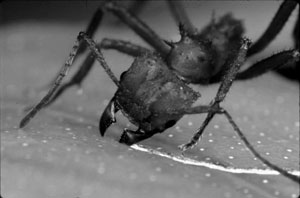|
HOME | SEARCH | ARCHIVE |
|
Photos worth a thousand words
Berkeley photographer, research associate captures treetop dwellers up close and personal
![]()
By Diane Ainsworth, Public Affairs
| |  Leaf cutter ant by Mark Moffett |
21 February 2001
|
They live in the secluded canopies of Earth’s rainforests. Woolly opossums, eyelash vipers, leaf-cutter ants, royal flycatchers, zebra butterflies, capuchin monkies, rhinoceros and goliath beetles, rainbow lorikeets, poisonous dart frogs. An award-winning National Geographic photographer, Moffett has trained his camera on some of Earth’s most elusive species. His collection of large-format color photographs, on display in the Marian Koshland Bioscience & Natural Resources Library (2101 Valley Life Sciences), will be expanded this month to include more breathtaking portraits of animals, reptiles and insects living secretive lives in the world’s treetops. Moffett takes to the trees several times a year on assignments for National Geographic, Natural History, Smithsonian and other large-circulation science magazines. The Harvard-trained scientist — the first ever to climb the world’s tallest tree — brings a naturalist’s eye to places high above ground, where most of Earth’s biodiversity resides. Since 1986, his images of ants, insects, spiders and frogs have appeared on the cover of National Geographic and routinely in many other science publications. In December 1991, he published an extensive article devoted to scientific research in the world’s rainforest canopies. His book, “The High Frontier: Exploring the Rain Forest Canopy,” led to several television specials, including a PBS documentary. “Anyone can have an adventure,” he said in the current December/January 2001 issue of Natural History magazine. “What nature photographers have is a whole lifetime of adventures. “Just off the top of my head, I clearly remember: in Peru, backing a jeep a quarter mile down an obscenely narrow mountain road flanked by a drop-off of hundreds of feet after meeting a vehicle that was too wide for me to pass…accidentally sitting on the New World’s most deadly snake, the fer-de-lance, again in Peru…crawling a hundred yards on hands and knees while tracking an ant column in Thailand, to suddenly realize I had accidentally sneaked up on a bull elephant that loomed overhead…” Among his most noteworthy images is a close-up of a seemingly harmless frog, Phyllobates terribilis, which turned out to be the most toxic amphibian in the world. Moffett was only the fourth non-native ever to explore a tiny, rarely visited valley in Western Colombia, where he encountered this vivid yellow creature. “I ran into this frog unexpectedly,” he said. “He’s appropriately named ‘the terrible one’ because his skin is poisonous and potentially lethal to the touch.” Using a Canon 50-mm macro lens, Moffett captured the frog just inches away. “These frogs are endangered and very valuable,” he said. “There are only 135 species left, all New World species.” Europeans collect them the way Americans collect tropical fish, but laws protect the diminutive amphibians from sport and commercial sale. A cover story on poisonous dart frogs, appearing in the May 1995 issue of National Geographic, featured Moffett’s photogenic subject, shot with a Canon 100-mm macro lens. Nocturnal life in the Brazilian rainforest produced another up close-and-personal photograph. This time it was the wide-eyed woolly opossum, which uses its clasping hands and feet to traverse trees. A surprise photograph, taken in 1983 with an Olympus 80-mm macro lens, shows the wide-eyed animal caught off guard by the flash of light two inches away. The night dweller stands only six to seven inches tall. The bioscience library collection includes a “samurai-looking” longhorn beetle, drenched in blood after slashing Moffett’s wrist in startled combat. The snapshot made its way onto the cover of the March 1998 issue of National Geographic. Found in French Guiana, the 5-inch-long beetle had reared up on a leaf of a spiny palm tree about 1 inch away from Moffett’s lens. In May, he will continue his adventures while on assignment in the fragile ecosystems of China. Among his key subjects: the shy and endangered panda.
So does Mark Moffett, a biologist and research associate at Berkeley’ Museum of Vertebrate Zoology.
“This is where you find incredible diversity in plants and animals,” said Moffett, who has won the top invitational awards in photography and journalism and a medal for writing from Harvard. “The world’s rainforest canopies can support a thousand tree species and be home to all kinds of animals that are not yet known to science.”
The poison dart frog on the Bastimentos Islands of Panama became the centerpiece of an amusing frog photo. Moffett caught the thumbnail-sized frog, not more than three-quarters of an inch big, sitting on top of a snail, poised and ready for the camera, with its jaw sticking out and its hands neatly folded in front of it.
“Don’t ask me how I will prepare for this shoot,” Moffett said. “I don’t know anything about pandas yet.”
Home | Search | Archive | About | Contact | More News
Copyright 2000, The Regents of the University of California.
Produced and maintained by the Office of Public Affairs at UC Berkeley.
Comments? E-mail berkeleyan@pa.urel.berkeley.edu.